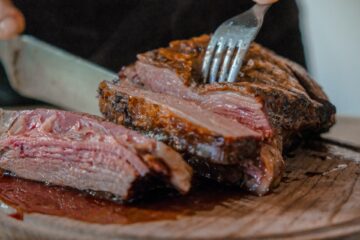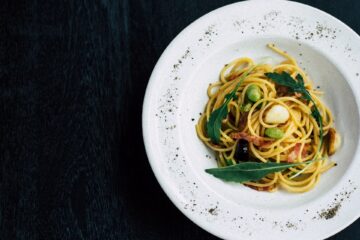When you find that old wheel of brie sitting on the counter or in the fridge, staring back at you, the first thing you think is ‘has it gone bad’, ‘is it still safe to eat’. Well, it’s one of two things – either you’ve lost it to spoilage or it’s just overripe. ‘But isn’t overripe still bad’, you might ask. Not necessarily.
Keep reading to find out a wide range of things to do with overripe brie. Fresh brie is very versatile and delicious, being overripe won’t just take that tasty goodness and versatility away. Have some more faith in one of the world’s greatest cheese. As long as it hasn’t gone bad, then there’s hope.
Understanding Overripe Brie
Brie is a soft, creamy cheese that originated in France and is made from cow’s milk. Over time, Brie can become overripe, resulting in changes to its appearance, texture, and taste. Understanding what overripe Brie is and what causes it can help you determine how to handle it and prevent it from happening in the future.
What is Overripe Brie?
Overripe Brie is a cheese that has been allowed to age beyond its optimal point. This can occur during production or while being stored. During the aging process, the enzymes in the cheese break down the proteins and fats, which results in the development of new flavors and textures. However, if Brie is aged too long or stored improperly, it can become overripe and take on characteristics that are undesirable.
Characteristics of Overripe Brie
The appearance of overripe Brie can vary depending on how long it has been aged. The cheese may develop a yellowish tint, or the white mold on the surface may turn brown or gray. The texture of overripe Brie can become very runny and almost liquid-like. Additionally, the smell of overripe Brie can be more pungent and sour than its fresh counterpart. The flavor of overripe Brie can be more robust and tangy than younger Brie, but it may also have a strong ammonia-like taste that some find unpleasant.
Why Overripe Brie Occurs?
Overripe Brie can occur for several reasons. Environmental factors, such as temperature and humidity levels during storage, can play a role in the development of overripe Brie. Brie should be stored in a cool, dry place, and excess moisture can lead to the growth of unwanted bacteria and mold. Additionally, overripe Brie can occur if it is not consumed in a timely manner. Brie is a perishable item, and it should be consumed within a week of purchase or before its expiration date to avoid overripeness.
In conclusion, understanding what overripe Brie is, its characteristics, and what causes it can help you prevent it from happening in the future. Proper storage and timely consumption can help ensure that your Brie stays fresh and delicious, while also reducing the amount of food waste in your household.
What to Do with Overripe Brie
Here are some delicious overripe brie recipes to try out:
- Baked brie cheese with honey
- Baked brie en croute
- Baked brie with figs, pistachios, and walnuts
- Baked brie dip
- Baked brie with pesto and sundried tomatoes
- Cinnamon apple bakes brie in puff pastry
- Garlic and herb baked brie
- Baked brie with pumpkin butter and walnuts
- Maple pecan baked brie
- Baked brie with pesto and garlic
- Bruschetta baked brie
- Brie skillet with cranberry, Brussel sprouts, and butternut squash
- Baked cranberry brie bites in puff pastry
- Baked brie with caramelized onions
- Baked brie with fig jam and bacon
- Stuffed chicken breast with apricot, walnut, and brie
- Spinach dip with brie
- Pasta with tomato, brie, basil, and spinach
- Blackberry and thyme baked brie
- Brie and apricot puff pastry
- Brie ice cream with parmesan toast
- Brie grilled cheese with roasted turkey and cranberry
- Bacon sandwich
Overripe brie can be enjoyed in any manner that you would normally enjoy brie. It also pairs nicely with champagne.
What Happens If You Eat Overripe Brie?
Nothing, overripe brie is just as good as fresh brie. If it is significantly old, it might not be as tasty but it’ll still be edible and can be used in your dishes. As long as it has not gone bad, then it is still safe to eat. Above is a list of the many different recipes that you can enjoy out with overripe brie.
Risks of consuming Overripe Brie
While overripe Brie can be used in some creative culinary and non-culinary ways, there are risks associated with consuming it. Overripe Brie can present health risks, spoilage, and food safety concerns, as well as changes in flavor and texture.
Health risks
Overripe Brie can pose health risks to those who consume it. As cheese ages, bacteria can grow and multiply on its surface. This can lead to the development of harmful bacteria, such as Listeria monocytogenes, which can cause serious illness or even death, especially in pregnant women, the elderly, and those with weakened immune systems. Consuming overripe Brie can increase the risk of exposure to these harmful bacteria and other microorganisms that can cause foodborne illness.
Spoilage and food safety
Overripe Brie can spoil and become unsafe to eat. As Brie ages, it can become too soft, slimy, or have an unpleasant odor. These are signs of spoilage and can indicate that the cheese has been contaminated with bacteria or mold. Ingesting spoiled Brie can lead to food poisoning and other gastrointestinal problems. It’s important to inspect Brie carefully for signs of spoilage before consuming it.
Flavor and texture changes
Overripe Brie can have changes in flavor and texture that may make it less desirable to eat. The texture of overripe Brie can become very runny, and the cheese may separate or ooze out of its rind. This can make it difficult to slice or serve, and the flavor can be more pungent or sour than its fresh counterpart. In some cases, the cheese may have a strong ammonia-like taste that some people find unpleasant.
How Can You Tell If Brie Is Bad?
Instead of a white and powdery exterior, if you notice any grey color, flakiness, or some natural mold on the rind of your brie, then the cheese has started to go bad and should be eaten immediately – preferably baked for proper sterilization. It might not taste as good or smell very good but stinky cheese is a preference to some. Leaving the cheese beyond this would render it inedible.
If you notice pink, slimy mold, hard texture around the edges, or green and blue spores, then you should toss it immediately. If you cut into it and notice any dark colors, terrible smells even after being aired out, the texture seems strange or the taste is awful, then you should toss it as well.
Note that bad smells don’t necessarily mean the cheese has gone bad. A slight ammonia smell is a natural sign of aging, but if you allow the cheese to air out a little and the smell becomes even stronger, then it should be discarded.
Creative ways to use Overripe Brie
While overripe Brie may not be ideal for eating on its own, there are several creative ways to use it in cooking and non-culinary applications. Here are some ideas to inspire you:
Culinary uses
- Recipes to use overripe brie: Overripe Brie can be used in several recipes, including baked dishes, soups and sauces, and sandwiches and burgers. Here are a few ideas: a. Baked Brie dishes: Overripe Brie can be used in baked dishes like Brie en croute, where the cheese is wrapped in puff pastry and baked until golden brown. The runny texture of the cheese makes it perfect for dipping bread or crackers into. b. Soups and sauces: Overripe Brie can be melted down and used as a base for creamy soups or sauces. Its tangy flavor pairs well with earthy ingredients like mushrooms or roasted vegetables. c. Sandwiches and burgers: Overripe Brie can be sliced and added to sandwiches or burgers for an extra kick of flavor. Pair it with savory meats like prosciutto or roasted turkey for a delicious combination.
- Pairings with other foods: Overripe Brie can be paired with a variety of other foods to create delicious flavor combinations. Here are a few ideas: a. Wine and cheese pairings: Overripe Brie pairs well with full-bodied red wines like Cabernet Sauvignon or Merlot. The cheese’s tangy flavor balances the tannins in the wine. b. Fruit and cheese platters: Overripe Brie can be served with fresh fruit like grapes or figs for a sweet and savory appetizer. The cheese’s soft texture pairs well with the crunch of nuts or the sweetness of honey. c. Charcuterie boards: Overripe Brie can be used as part of a larger charcuterie board. Pair it with cured meats like salami or prosciutto, olives, and crackers for a perfect party platter.
Non-Culinary uses
- Homemade beauty products: Overripe Brie can be used in homemade beauty products like facial masks and scrubs or hair treatments. The lactic acid in the cheese can help to exfoliate and moisturize the skin, while the protein can help to strengthen and nourish hair. a. Facial masks and scrubs: Mix overripe Brie with other ingredients like honey and oats to create a hydrating facial mask or scrub. The cheese’s texture helps to gently exfoliate the skin, while the honey and oats help to moisturize. b. Hair treatments: Mix overripe Brie with olive oil and honey to create a hair treatment. Apply to damp hair, let sit for 30 minutes, and rinse out for shiny, nourished locks.
- Gardening: Overripe Brie can be used in gardening as well. Here are a few ideas: a. Composting: Overripe Brie can be added to your compost bin to add nitrogen-rich material. The cheese will break down over time and help to fertilize your soil. b. Soil enrichment: Overripe Brie can also be used to enrich soil in potted plants. Mash the cheese into small pieces and mix with soil before planting. The cheese’s protein and fat content can help to enrich the soil and nourish the plant.
How to store Brie to avoid overripeness
Proper storage is essential to keep Brie fresh and prevent it from becoming overripe. Here are some guidelines to follow to ensure that your Brie stays in good condition:
Proper storage guidelines
- Temperature: Brie should be stored at a cool temperature, between 35-45°F (2-7°C). If possible, store it in the warmest part of your refrigerator, such as the door or the top shelf.
- Packaging: Keep Brie in its original packaging until you are ready to use it. If the original packaging is damaged, wrap the cheese tightly in plastic wrap or aluminum foil to keep out air and moisture.
- Humidity: Brie should be stored in a humid environment. If your refrigerator is too dry, place a damp paper towel in the container or wrap the cheese in a damp towel or cheesecloth.
Tips for preventing overripe Brie
- Buying and storing strategies: Buy Brie as close to the date that you plan to use it as possible. Check the expiration date on the packaging and consume it before that date. If you’re not planning to use it right away, freeze it for later use.
- Rotation and consumption advice: Brie is a perishable item, and it’s important to consume it within a week of purchase. If you have leftover Brie, store it properly, and use it in recipes within a day or two.
Tips for using leftover Brie
- Freezing techniques: Brie can be frozen for later use. Cut the cheese into small portions or cubes, wrap it tightly in plastic wrap or aluminum foil, and place it in a freezer bag. Freeze for up to six months. Thaw in the refrigerator before using.
- Incorporating into meals and snacks: Use leftover Brie in recipes or snacks like sandwiches, salads, or cheese platters. The cheese’s flavor and texture changes may be less noticeable when used in dishes with other ingredients.
How Long Is Brie Cheese Good For?
If properly packed and stored in the fridge, brie cheese can last for up to two weeks after it has been opened. Brie cheese is typically soft cheese and the softer the cheese, the shorter the lifespan. The best way to store cheese to make it last longer is to wrap it in parchment or wax paper or its original wrapper, then wrap it again with a plastic film or foil for extra preservation and keep it in the back of the fridge or the cheese/vegetable drawer of your fridge.
Unopened brie cheese can last up to 8 weeks and even 2-3 weeks after the best before date.
Is It Ok To Freeze Brie Cheese?
We do not recommend freezing brie cheese if you are not planning to cook it after defrosting. The texture of brie will change significantly and will not give the same results after being frozen, so if you plan to eat it by itself after defrosting then you should not freeze it.
If you’re going to freeze brie cheese, then the best way to do it would be to slice it into smaller pieces so you can defrost only as much as you need. Wrap it in parchment or wax paper and then again with foil or plastic film, then place it in an airtight container before putting it in the freezer. Brie cheese can last up to 6 months in the freezer if packed properly. Note that you should never refreeze thawed brie, that’s why we recommend freezing it in pieces.
Read also: How Long Does Liquid Egg White Last?
Can You Get Food Poisoning From Old Brie?
You can get a bacterial infection when you eat old brie that’s contaminated with Listeria. It typically feels like the bad flu with symptoms like fatigue, fever, chills, vomiting, lack of appetite, nausea, muscle aches, and pains. If the infection reaches the immune system, the symptoms could include confusion, lack of coordination, seizures, poor balance, stiff neck, and severe headaches.
If you have an allergy to mold, it is best to avoid brie cheese. You can also get infected by other germs like E Coli, campylobacter, salmonella, and cryptosporidium.
What can I do with leftover brie rind?
The rind of Brie cheese is edible, but it’s often discarded. However, the rind can be used in several creative ways. Here are a few ideas:
- Flavoring Soups or Stews: Add the rind to soups or stews for a rich, creamy flavor. Simmer the soup or stew with the rind in it, and remove the rind before serving.
- Infusing Oil or Vinegar: Use the rind to infuse oil or vinegar for a unique flavor. Heat the oil or vinegar on low heat, and add the rind to the pot. Let it simmer for a few minutes, and then remove the rind.
- Making Stock or Broth: Add the rind to stock or broth for a richer flavor. Simmer the rind with vegetables and herbs, and remove the rind before using the stock or broth.
- Homemade Croutons: Use the rind to make homemade croutons. Cut the rind into small pieces, toss with olive oil and seasonings, and bake until crispy.
- Cheese Spread: Blend the rind in a food processor with other soft cheeses, such as cream cheese or goat cheese, for a flavorful cheese spread.
Can I remelt Brie?
Yes, you can remelt Brie. Brie cheese has a high-fat content, which means that it can melt easily when heated. This makes it a great cheese to use in melted dishes such as fondues, dips, and sauces.
To remelt Brie, simply heat it in a pan on low heat or in the microwave for short intervals until it reaches the desired consistency. Be careful not to overheat the cheese, as it can become too runny and lose its flavor. It’s best to heat Brie slowly and stir it frequently to ensure that it melts evenly.
Keep in mind that remelted Brie may have a different texture and flavor than freshly melted Brie. Overheating can cause the cheese to separate and become oily. It’s best to use remelted Brie immediately and avoid reheating it again.
What Meats Go With Brie?
Here are some great meats that go well with brie:
- Turkey
- Beef
- Sopressa
- Prosciutto
- Toscano
- Salami
- Chicken
- chorizo
Read also: Does Mirin Need to Be Refrigerated?
Best Toppings For Cold Brie Cheese
Some of the best toppings to dress up brie cheese with are:
- Asian pear and arugula
- Prosciutto and fig
- Orange marmalade with rosemary
- Sun-dried tomatoes and artichokes
- Roasted mushrooms and thyme
- Spiced caramel with pumpkin seed
- Mango chutney with roasted peanuts
- Apple crisp
- Wine soaked berries
- Roasted grapes
Conclusion
This article proves that there are several delicious things to do with overripe brie and several dishes, toppings, and side dishes that go well with brie. It can be both fun and delicious to experiment with your food. Be creative, make your recipes – anything to avoid wasting food.




